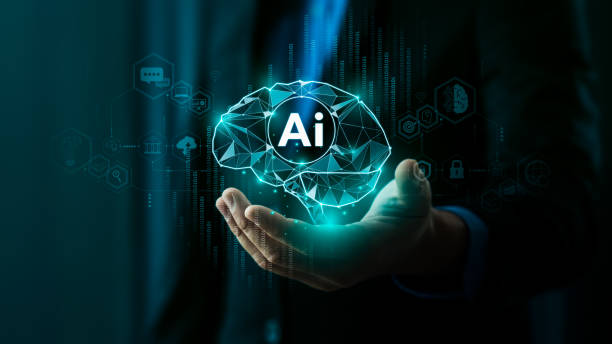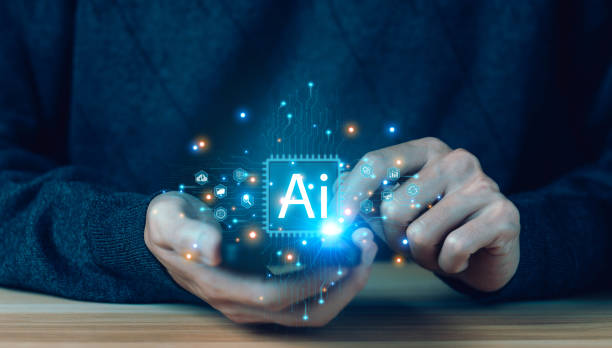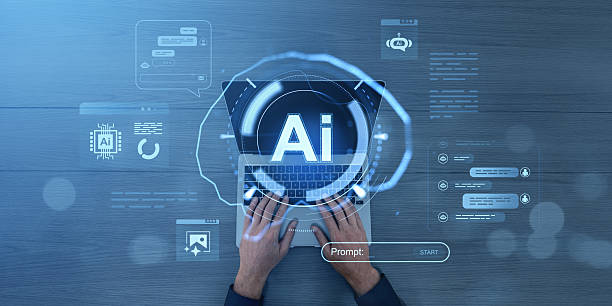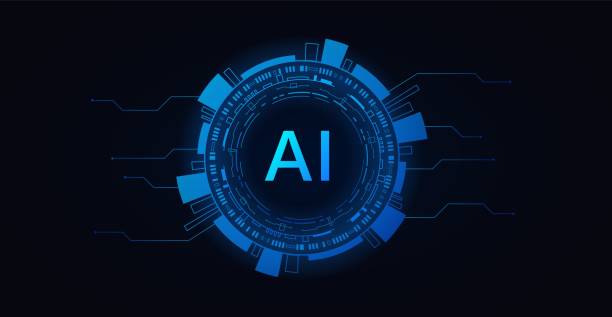What is Artificial Intelligence? Definitions and Basic Concepts

Artificial Intelligence (AI) is a branch of computer science dedicated to building machines that can perform tasks that typically require human intelligence.
These tasks include learning, reasoning, problem-solving, understanding natural language, and recognizing patterns.
In other words, the goal of #Artificial_Intelligence is to simulate human intelligence in machines so that they can make decisions and act independently.
In a simpler definition, artificial intelligence refers to a set of algorithms and techniques that enable computers to perform tasks requiring understanding, reasoning, and learning.
This definition encompasses a wide range of applications, including robotics, natural language processing, computer vision, and expert systems.
AI strives to empower machines to acquire knowledge through data and experience, enabling them to make decisions in various situations.
Artificial Intelligence on Wikipedia
Key concepts in artificial intelligence include Machine Learning, Deep Learning, Neural Networks, and Natural Language Processing.
Each of these concepts plays a crucial role in the development and advancement of artificial intelligence.
Are you concerned about your e-commerce website’s low conversion rates and not achieving your desired sales?
Rasawab is your specialized solution for a successful e-commerce website.
✅ Significant increase in conversion rates and sales
✅ Professional and user-friendly design to attract customer satisfaction
⚡ Ready for a transformation in online sales? Get a free consultation!
History of Artificial Intelligence from Inception to Today

The history of Artificial Intelligence dates back to the 1950s, when researchers began exploring the possibility of building machines capable of performing intelligent tasks.
The term “Artificial Intelligence” was first coined in 1956 at a conference at Dartmouth College.
In the early years, researchers focused on solving logical problems and developing programs that could play games like chess.
One of the pioneers in this field was Alan Turing, who introduced the Turing Test as a criterion for measuring machine intelligence.
In the 1960s and 1970s, despite initial advancements, artificial intelligence encountered limitations.
A lack of processing power and sufficient data slowed down progress.
Consequently, research funding decreased, and this period became known as the “AI winter.”
In the 1980s and 1990s, with the development of Expert Systems and the increase in computer processing power, artificial intelligence regained attention.
Expert systems were programs that encapsulated specialized knowledge in a particular domain and could act as consultants.
However, these systems also had limitations and could not fully meet expectations.
In the 21st century, with remarkable advancements in machine learning and deep learning, artificial intelligence entered a new era.
Access to Big Data and increased computer processing power enabled the development of more complex and efficient algorithms.
Today, artificial intelligence is applied in various fields, including autonomous vehicles, medicine, marketing, and customer services.
Types of Artificial Intelligence and Their Applications

Artificial intelligence can be divided into different categories based on its capabilities and applications.
One of these classifications is based on the machines’ ability to perform various tasks.
In this categorization, AI is divided into two main types: Narrow AI and General AI.
Narrow AI refers to machines designed to perform a specific task.
This type of artificial intelligence is used in various fields such as facial recognition, language translation, and computer games.
For example, the facial recognition system in smartphones is an example of Narrow AI, designed solely for face detection.
Narrow AI is currently used in many industries and services and plays a significant role in improving efficiency and accuracy.
General AI refers to machines capable of performing any task that a human can do.
This type of artificial intelligence is still in the research stages, and no complete machine with General AI has been built yet.
The goal of developing General AI is to create machines that can learn, reason, and make decisions in various situations.
The development of General AI comes with many technical and ethical challenges.
Furthermore, artificial intelligence can be categorized based on learning methods.
Machine Learning, Deep Learning, and Reinforcement Learning are among these methods.
Each of these methods has applications in various fields, including natural language processing, computer vision, and robotics.
| AI Type | Description | Applications |
|---|---|---|
| Narrow AI | Machines designed to perform a specific task. | Facial recognition, language translation, computer games |
| General AI | Machines capable of performing any task that a human can do. | Still in research stages |
Machine Learning and its Role in Artificial Intelligence

Machine Learning is a significant subfield of Artificial Intelligence that enables machines to learn from data without explicit programming.
In essence, machine learning allows machines to identify patterns and relationships within data by analyzing it, and based on these patterns, they improve their predictions and decisions.
Machine learning is applied in various fields, including pattern recognition, market prediction, and data analysis.
There are various methods for machine learning, including Supervised Learning, Unsupervised Learning, and Reinforcement Learning.
In supervised learning, the machine is trained using Labeled Data.
In other words, data with correct answers is provided to the machine, and it attempts to learn the relationship between the data and the answers.
In unsupervised learning, the machine is trained using Unlabeled Data.
The goal of this method is to identify patterns and structures within the data.
In reinforcement learning, the machine is trained through trial and error, receiving rewards and penalties.
The machine strives to learn behaviors that yield the highest rewards.
Machine learning plays a very important role in the development of Artificial Intelligence.
Many of today’s AI systems use machine learning algorithms to perform various tasks.
For example, facial recognition systems, language translation, and product recommendation systems use machine learning algorithms to improve their accuracy and efficiency.
Recent advancements in Deep Learning have also had a significant impact on AI development.
Deep learning, using Artificial Neural Networks, enables the learning of more complex and accurate patterns.
Is your company’s website as professional and trustworthy as it should be? With specialized corporate website design by Rasawab, create an online presence that reflects your credibility and attracts more customers.
✅ Build a powerful and professional image for your brand
✅ Convert visitors into real customers
⚡ Get a free consultation now!
What is Deep Learning and What are its Applications?

Deep Learning is a subfield of machine learning built upon Artificial Neural Networks.
Artificial neural networks consist of multiple layers of interconnected nodes.
These networks are designed inspired by the structure of the human brain and are capable of learning complex and precise patterns from data.
One of the important features of deep learning is its ability for automatic Feature Learning.
In traditional machine learning methods, the features required for model training must be manually extracted by experts.
However, in deep learning, neural networks can automatically extract important features from data.
This characteristic makes deep learning highly efficient for solving complex and diverse problems.
Deep learning has applications in various fields, including Computer Vision, Natural Language Processing, and Speech Recognition.
In computer vision, deep learning is used for detecting and identifying objects in images and videos.
In natural language processing, deep learning is used for language translation, sentiment analysis, and text generation.
In speech recognition, deep learning is used for converting speech to text.
One of the important applications of deep learning is Self-Driving Cars.
Self-driving cars use deep neural networks to detect road signs, identify pedestrians, and navigate.
Deep learning enables self-driving cars to operate safely and independently in various driving conditions.
Natural Language Processing (NLP) and Its Applications

Natural Language Processing (NLP) is a branch of Artificial Intelligence that deals with the interaction between computers and human languages.
The goal of natural language processing is to build machines capable of understanding, interpreting, and generating human languages.
Natural language processing is applied in various fields, including language translation, sentiment analysis, text generation, and chatbots.
One of the important applications of natural language processing is Language Translation.
Language translation systems use natural language processing algorithms to translate text from one language to another.
These systems can automatically translate text and provide a correct understanding of its meaning.
Language translation is used in various fields, including international trade, tourism, and intercultural communication.
Sentiment Analysis is another important application of natural language processing.
Sentiment analysis enables computers to identify emotions and opinions present in text.
This analysis can be applied in various fields, including marketing, customer service, and social media analysis.
For example, companies can use sentiment analysis to evaluate customer feedback about their products and services.
Text Generation is another important area of natural language processing.
Text generation systems can automatically produce new texts.
These systems can be used for generating news articles, text summarization, and answering questions.
Text generation is applied in various fields, including journalism, education, and content creation.
Challenges and Limitations of Artificial Intelligence

Despite significant advancements in the field of Artificial Intelligence, this technology still faces challenges and limitations.
One of these challenges is the need for Big Data.
Many machine learning and deep learning algorithms require a large volume of data for training.
Collecting and preparing this data can be time-consuming and costly.
Another challenge of Artificial Intelligence is Interpretability.
Many deep learning models are known as “black boxes,” meaning it’s not easy to understand how these models arrive at their decisions.
This issue can be problematic in fields such as medicine and law, as the reasoning behind AI decisions needs to be explainable.
Another challenge is Bias in data.
If the data used to train AI models is biased, the models may also make biased decisions.
For example, if a facial recognition system is trained using data predominantly featuring Caucasian faces, it may perform poorly in recognizing non-Caucasian faces.
Addressing bias in AI data and models is a significant challenge.
Furthermore, Ethical Issues are also a crucial challenge for Artificial Intelligence.
The use of AI in areas such as autonomous weapons and surveillance systems can raise serious ethical concerns.
It is necessary to formulate appropriate laws and regulations for the use of AI to prevent the misuse of this technology.
| Challenge | Description | Solutions |
|---|---|---|
| Need for Big Data | Machine learning algorithms require a large volume of data. | Improvement of data collection and preparation methods |
| Interpretability | The reasoning behind AI decisions is not explainable. | Development of more interpretable models |
| Bias in data | Training data is biased. | Addressing bias in data and models |
The Future of Artificial Intelligence and Its Impact on Human Life

The future of Artificial Intelligence appears very bright and promising.
With continuous advancements in machine learning and deep learning, AI is expected to play an even more significant role in human life in the coming years.
Autonomous vehicles, home robots, smart medical systems, and virtual assistants are just a few examples of potential AI applications in the future.
One of the significant impacts of Artificial Intelligence on human life is the transformation of the job market.
With the automation of many tasks, some jobs may disappear, but at the same time, AI can also create new job opportunities.
To benefit from these opportunities, individuals need to acquire new skills and adapt to changes in the job market.
Artificial Intelligence can also play a crucial role in improving the quality of human life.
Smart medical systems can help with early disease diagnosis and provide more effective treatments.
Home robots can assist with daily tasks and make life easier.
Virtual assistants can help individuals manage schedules and information, thereby increasing productivity.
However, it is also necessary to pay attention to the potential challenges and risks of Artificial Intelligence.
Ethical, security, and social issues must be seriously considered to prevent the misuse of this technology.
Developing appropriate laws and regulations can help manage risks and capitalize on the benefits of AI.
Are you falling behind in the competition with large online stores?
Rasawab, with professional e-commerce website design, will bring your business online and increase your market share!
✅ Increase brand credibility and customer trust
✅ Easy shopping experience leading to more sales
⚡ Act now to get a free website design consultation!
Opportunities and Threats of Artificial Intelligence

Artificial Intelligence, like any other technology, presents both opportunities for human progress and life improvement, as well as threats that must be considered.
Among the opportunities of AI are improved efficiency and productivity in various industries, the development of smart medical systems, the creation of new job opportunities, and the facilitation of daily life.
For example, in the manufacturing industry, AI can help automate processes, improve product quality, and reduce costs.
In the healthcare sector, smart medical systems can assist with more accurate disease diagnosis, provide personalized treatments, and improve resource management.
In education, AI can contribute to creating adaptive learning systems, offering personalized feedback, and increasing access to education.
Among the threats of Artificial Intelligence are the loss of some jobs due to automation, increased social inequality, the misuse of AI in military and security domains, and the emergence of new ethical issues.
It is necessary to address these threats and propose solutions to mitigate them.
To capitalize on the opportunities of Artificial Intelligence and mitigate its threats, governments, organizations, and individuals must collaborate to formulate appropriate policies and regulations.
Education and awareness about AI also play a crucial role in managing risks and harnessing the benefits of this technology.
How to Learn Artificial Intelligence? Resources and Learning Paths

Learning Artificial Intelligence can be an exciting and rewarding journey.
To begin learning AI, you can use various resources such as online courses, books, scientific articles, and practical projects.
Online courses are one of the best ways to learn AI.
Websites like Coursera, edX, and Udemy offer various courses in AI that you can utilize.
Books are also valuable resources for learning Artificial Intelligence.
Various books are available on machine learning, deep learning, and natural language processing that you can study.
Scientific articles can also help you understand more advanced concepts of AI.
Websites like arXiv and IEEE Xplore publish various scientific articles in the field of AI.
Practical projects are one of the best ways to learn Artificial Intelligence.
By undertaking practical projects, you can implement theoretical concepts in practice and strengthen your skills.
You can use ready-made projects or design your own.
Websites like GitHub offer various open-source projects in the field of AI.
To learn Artificial Intelligence, you can follow a specific learning path.
For example, you can start by learning basic concepts of mathematics and statistics, then move on to machine learning and deep learning concepts, and finally, undertake various practical projects.
Additionally, you can join online AI communities and interact with other enthusiasts in this field.
Frequently Asked Questions
| Question | Answer |
|---|---|
| What is the definition of Artificial Intelligence? | It is a field in computer science that aims to create intelligent machines capable of thinking, learning, problem-solving, and decision-making like humans. |
| Mention some common applications of Artificial Intelligence. | These include self-driving cars, voice assistants (like Siri and Alexa), recommendation systems (like Netflix and Amazon), facial recognition, and medical diagnosis. |
| What is the difference between Narrow AI (ANI) and General AI (AGI)? | Narrow AI is specialized in one specific task, while General AI possesses human-level intellectual ability to perform any cognitive task. |
| What is Machine Learning and its relation to Artificial Intelligence? | Machine Learning is a branch of Artificial Intelligence that focuses on developing algorithms that allow systems to learn from data without explicit programming. |
| What are Artificial Neural Networks? | They are computational models inspired by the structure and function of the human brain, used in deep learning to process data and discover complex patterns. |
| Mention some ethical challenges related to Artificial Intelligence. | These include privacy issues, bias in data and algorithms, job displacement, and accountability in case of errors or unfair decisions. |
| What is Natural Language Processing (NLP)? | It is a branch of Artificial Intelligence that focuses on enabling computers to understand, interpret, and generate human language in a useful and interactive way. |
| How can Artificial Intelligence affect the job market? | It can lead to the automation of some routine tasks, requiring retraining of workers and creating new jobs in the areas of designing, developing, and maintaining AI systems. |
| What is Computer Vision? | It is a field in Artificial Intelligence that enables computers to “see,” understand, and interpret images and videos in the same way humans do, allowing them to recognize objects and faces. |
| What is the importance of data in developing Artificial Intelligence systems? | Data is the fuel that powers Artificial Intelligence systems, especially in machine learning. The quality and quantity of data significantly affect the accuracy and performance of models and their ability to learn and make correct decisions. |
And other advertising services from Rasawab Advertising Agency in the field of advertising
Smart Advertising Campaign: Professional optimization to attract customers using key page optimization.
Smart Conversion Rate Optimization: Designed for businesses seeking to attract customers through intelligent data analysis.
Smart Marketplace: Professional optimization for digital branding using real data.
Smart Link Building: A creative platform for improving click-through rates with Google ad management.
Smart Marketplace: A fast and efficient solution for attracting customers, focusing on attractive user interface design.
And over hundreds of other services in internet advertising, advertising consultation, and organizational solutions
Internet Advertising | Advertising Strategy | Advertorials
Resources
What is Artificial Intelligence?
Artificial Intelligence articles and news on Zoomit
Applications of Artificial Intelligence
Artificial Intelligence news and articles on Digiato
? Ready to transform your business in the digital world? Rasawab Afarin Digital Marketing Agency, with expertise in various fields including professional website design, SEO, and social media management, paves your path to growth and success.
📍 Tehran, Mirdamad Street, next to Bank Markazi, Southern Kazeroon Alley, Ramin Alley, No. 6




